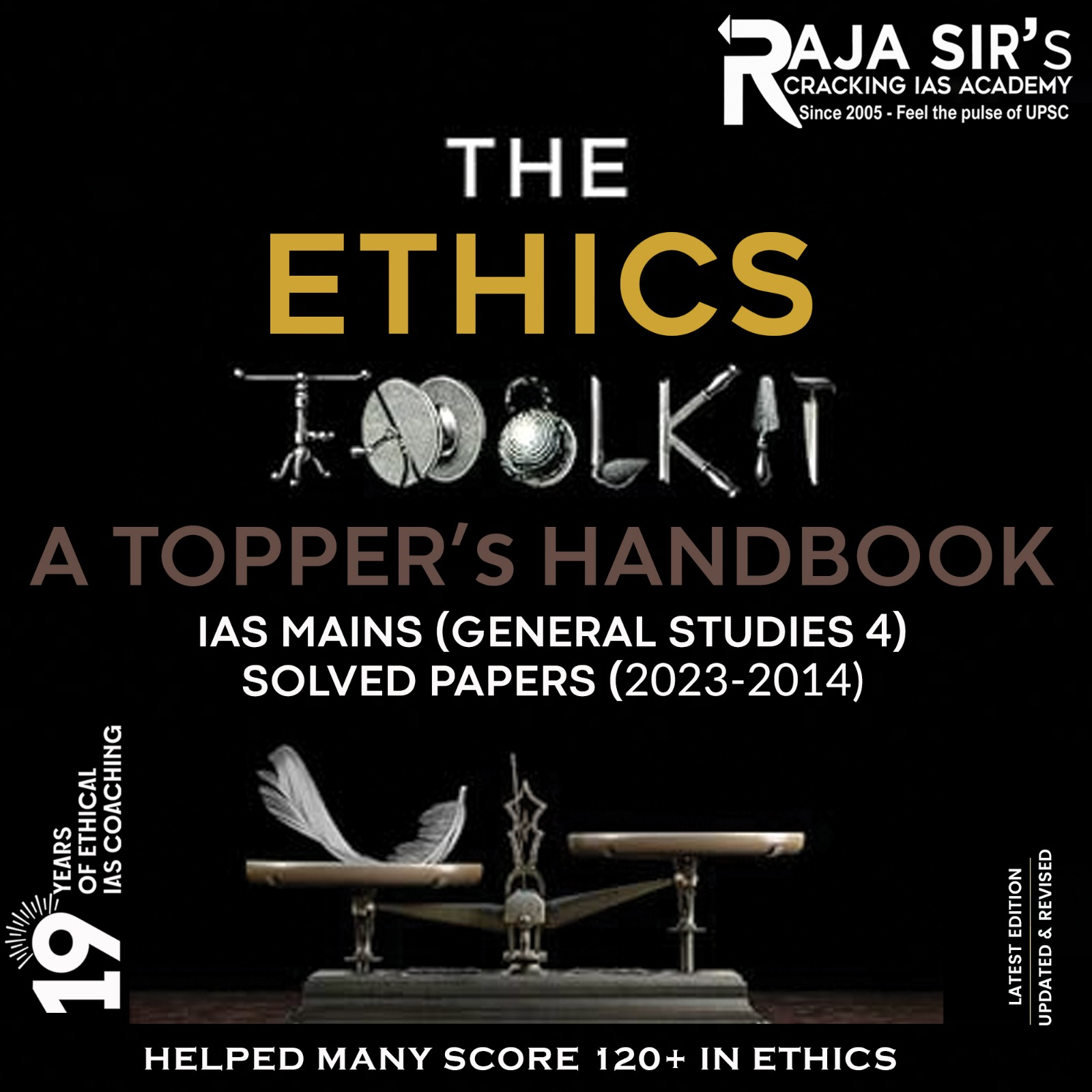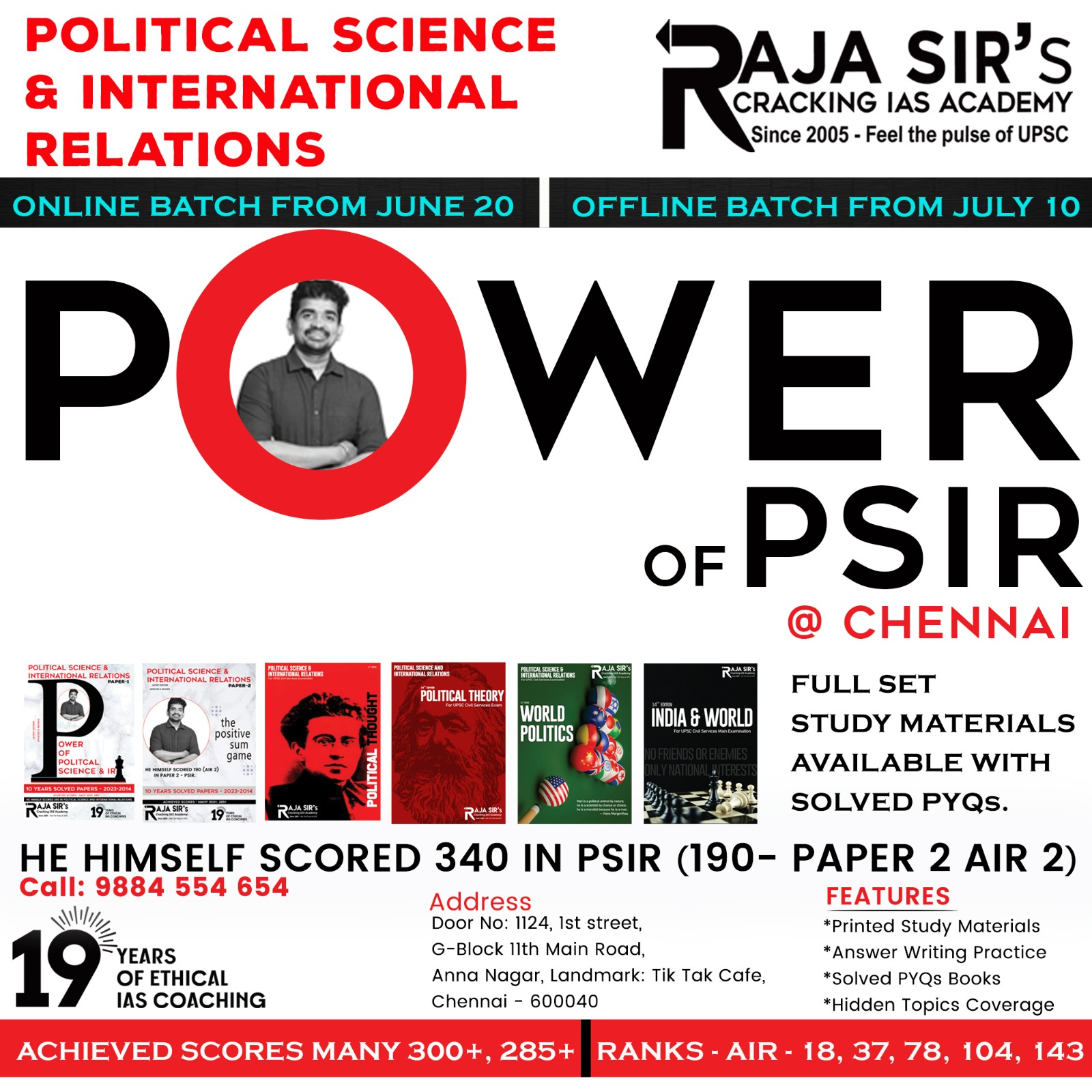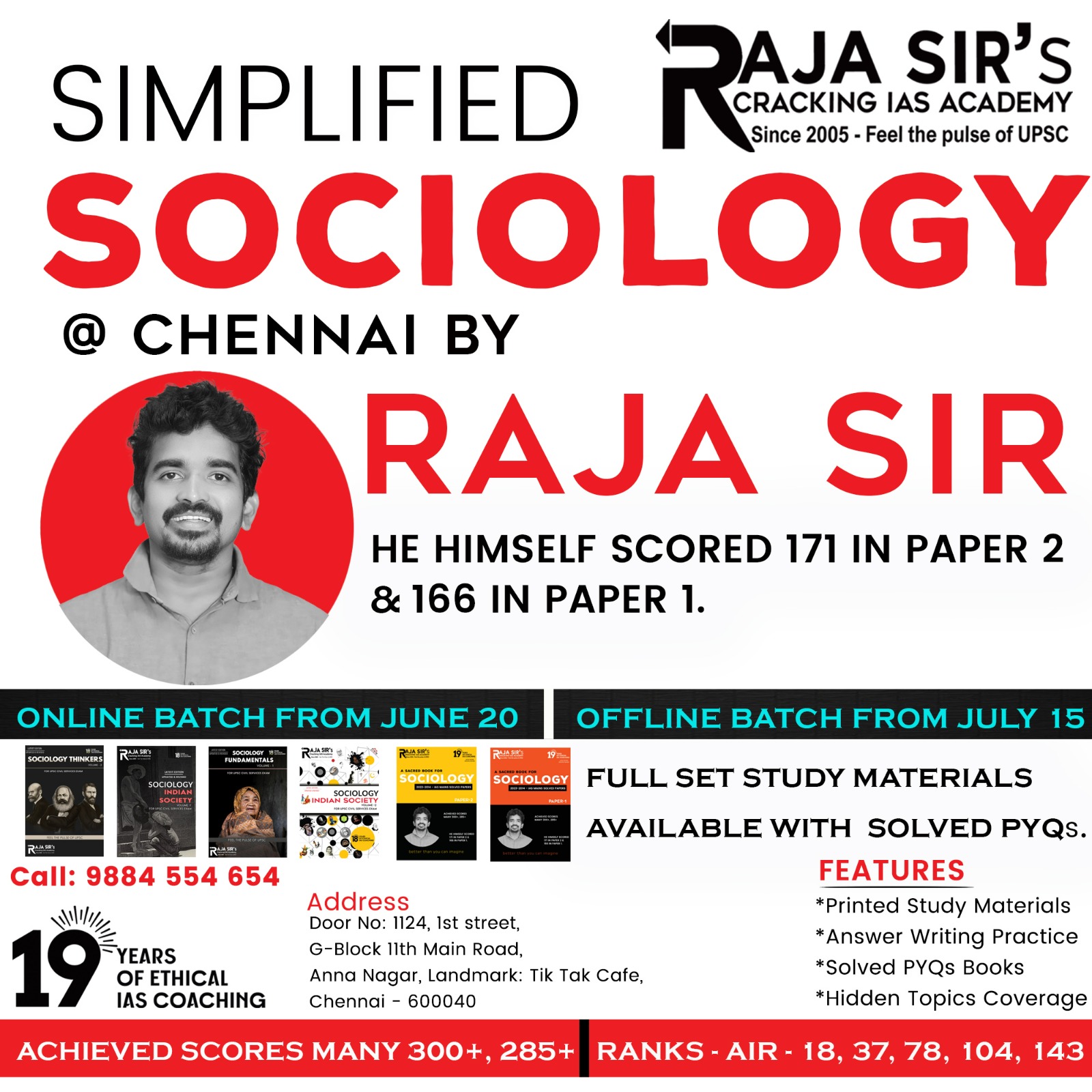- Home
- Prelims
- Mains
- Current Affairs
- Study Materials
- Test Series
 EDITORIALS & ARTICLES
EDITORIALS & ARTICLES
Hit List Questions 71-PPP 100 PRELIMS 2024 - 89
Questions & Explanations:
|
1. |
Consider the following. 1. It is a two-stage missile with a liquid propellant booster engine. 2. It has a very low radar signature. Which of the above is/are correct w.r.t. BrahMos missile? (a) 1 only (b) 2 only (c) 1 and 2 (d) Neither 1 Nor 2
|
||||||||||
|
2. |
With reference to Mughal India, what is/are the difference/differences between Jagirdar and Zamindar? 1. Jagirdars were holders of land assignments in lieu of judicial and police duties, whereas Zamindars were holders of revenue rights without obligation to perform any duty other than revenue collection. 2. Land assignments to Jagirdars were hereditary and revenue rights of Zamindars were not hereditary. Select the correct answer using the code given below. (a) 1 only (b) 2 only (c) Both 1 and 2 (d) Neither 1 nor 2
|
||||||||||
|
3. |
Consider the following statements. 1. At Ibadat Khana in Fatehpur Sikri, Akbar established the syncretic faith known as ''Din-e-Illahi.'' 2. Akbar discontinued the debates in the Ibadat Khana. Which of the statements given above is/are correct? (a) 1 only (b) 2 only (c) Both 1 and 2 (d) Neither 1 nor 2
|
||||||||||
|
4. |
Who among the following founded several organisations titled, ‘National’ - National Paper, National Society, National School, National Theatre, National Store, National Press, National Gymnasium and National Circus? (a) Nabagopal Mitra (b) Rajnarain Bose (c) Bankim Chandra Chatterjee (d) Vishnu Shastri Chiplunkar
|
||||||||||
|
5. |
Consider the following statements. 1. Hezbollah is a Shiite militant organization. 2. Hamas is a Sunni Islamist militant group. 3. The Houthis are a Shiite Muslim sect in Yemen. 4. Syria''s secretive Force is called as Quds Force. Which of these is/are true?. (a) 1, 2 and 4 only (b) 3 and 4 only (c) 1, 2 and 3 only (d) 1 and 3 only
|
||||||||||
|
6. |
Which of the following statements is/are true?. 1. Tribhanga posture is prominent in Amaravati sculptures. 2. Sculptures composition in Amaravati stupas are more complex than at sanchi. (a) Both 1 and 2 (b) 2 only (c) 1 only (d) Neither 1 nor 2
|
||||||||||
|
7. |
Consider the following statements: 1. Wima Kadiphises patronised Mathura Art & built a stupa at Purushpur. 2. Satavahanas patronised the Amaravati school of sculpture. Which of the statements given above is/are correct? (a) Both 1 and 2 (b) 2 only (c) 1 only (d) Neither 1 nor 2
|
||||||||||
|
8. |
Who gave rules of using zero with other numbers?. (a) Apstamba (b) Aryabhatta (c) Brahmagupta (d) Varahamihir
|
||||||||||
|
9. |
Aflatoxin contamination is caused due to (a) Virus (b) Bacteria (c) Fungi (d) Prions
|
||||||||||
|
10. |
The Svalbard Global Seed Vault is owned by (a) Finland (b) Norway (c) Denmark (d) Northern Ireland
|
||||||||||
|
11. |
1. While dark matter attracts and holds galaxies together, dark energy repels and causes the expansion of our universe. 2. Roughly 68% of the universe is dark matter and dark energy makes up about 27%. Which of the statements given above is/are correct w.r.t. Dark energy & Dark matter?. (a) 1 only (b) 2 only (c) Both 1 and 2 (d) Neither 1 nor 2
|
||||||||||
|
12. |
The India-led Group of Friends (GOF) at the United Nations focuses on (a) Reforming UNSC (b) Crimes against UN peacekeepers (c) South – South Cooperation (d) Funding UN Initiatives for refugees
|
||||||||||
|
13. |
Adi Sankaracharya is associated with 1. Maya Theory 2. Advaita Vedanata 3. Tarak Brahma (a) 2 only (b) 1 and 2 only (c) 2 and 3 only (d) 1, 2 and 3
|
||||||||||
|
14. |
The key objectives of the CBG Blending Obligation (CBO) will include 1. import substitution for Liquefied Natural Gas 2. saving in Forex 3. promoting circular economy 4. to assist in achieving the target of net zero emission (a) 3 & 4 (b) 1, 3 & 4 (c) 1, 2, 3 & 4 (d) 1 & 4
|
||||||||||
|
15. |
A well-known story of Hungry Tigress in Indian History exemplifies the (a) Sacredness of Aranyakas (b) Profane morality of Parsis (c) Basic tenets of Jainism (d) Buddhist teachings
|
||||||||||
|
16. |
The “Principal Purpose Test” was in news in relation to (a) Environmental Impact Assessment (b) Constituional Morality (c) Tax Treaty (d) Social Audit of MGNREGA
|
||||||||||
|
17. |
1. Dry Ice 2. Sodium chloride 3. Potassium iodide How many of these is/are used as seeding agents in Cloud Seeding? (a) Only one (b) Only two (c) All the three (d) None of these
|
||||||||||
|
18. |
Match List-I with List-II and select the correct answer using the code given below the Lists:
Codes: A B C D (a) 2 4 3 1 (b) 1 3 4 2 (c) 2 3 4 1 (d) 1 4 3 2
|
||||||||||
|
19. |
1. Alauddin Khilji’s rule was constantly threatened by the Mongol invasions. 2. Alauddin Khilji acquired the kohinoor diamond in his Warangal expedition. Which of the statements given above is/are correct? (a) 1 only (b) 2 only (c) Both 1 and 2 (d) Neither 1 nor 2
|
||||||||||
|
20. |
Kangra school of painting is associated with 1. Miniature paintings inspired from Vaishnavite traditions. 2. Migration of Mughal artists to the hills from the plains following Nadir Shah’s invasion. Which of the above is/are incorrect?. (a) Only 1 (b) Only 2 (c) Both 1 and 2 (d) Neither 1 nor 2
|
||||||||||
|
21. |
1. It depicts devotional messages under the neo-Vaishnavite tradition. 2. Srimanta Sankardeva established this art of masks. Which of the statements given above is/are correct w.r.t. Majuli Masks? (a) 1 only (b) 2 only (c) Both 1 and 2 (d) Neither 1 nor 2
|
||||||||||
|
22. |
Naga Bandha mudra or the shape of ‘8’ is an important posture of (a) Manipuri dance (b) Kathak (c) Mohiniyattam (d) Sattriya Nritya
|
||||||||||
|
23. |
1. Section 77 of the Representation of the People Act, 1951 (RP Act) provides for law relating to star campaigners. 2. Only recognised political parties can have the star campaigners. Which of the statements given above is/are correct w.r.t. star campaigners?. (a) 1 only (b) 2 only (c) Both 1 and 2 (d) Neither 1 nor 2
|
||||||||||
|
24. |
The “BBNJ Treaty” seen in news is an agreement on the (a) Conservation of Biodiversity (b) High Seas conservation (c) Bangladesh Bhutan Taxation (d) Bay of Bengal clean up inititaive
|
||||||||||
|
25. |
1. Hindu calendar is a lunar calendar. 2. Gregorian calendar is a solar calendar. 3. Solar year is longer than a lunar year. How many of these statements is/are true?. (a) Only one (b) Only two (c) All the three (d) None of these
|
EXPLANATIONS
|
1. |
https://indianexpress.com/article/explained/brahmos-missiles-philippines-development-9280055/ BrahMos is a two-stage missile with a solid propellant booster engine. Its first stage brings the missile to supersonic speed (meaning faster than sound) and then gets separated. The liquid ramjet or the second stage then takes the missile closer to three times the speed of sound in cruise phase. The missile has a very low radar signature, making it stealthy, and can achieve a variety of trajectories. The ‘fire and forget’ type missile can achieve a cruising altitude of 15 km and a terminal altitude as low as 10 m to hit the target. |
B |
|||||||||||||||||||||
|
2. |
Jagirdar and Zamindar were two types of intermediaries that collected the land revenue for king during Mughal Period. Jagirdar and Zamindar enjoyed the rights of the land by paying fixed share of collection to King. Jagirdar were official man of King’s who enjoy the land gifted from King. They also called Mansabdar. They allotted non inherited land equivalent to their Jagir( fee). Jagirdar only have right to claim and enjoy revenue collected from Land. Jagirdar were not the permanent holder of land. The peasant and Zamindars comes under Jagirdar. Jagirdar has right to remove a Zamindar or detain peasants. Zamindar: Holder of the land is called Zamindar. They has hereditary right to claim share of peasants output other than land revenues. They have right to detain peasants. In Mughal period, revenue fixed by Kingdom but amount payable depends on discretion on jagirdar and zamindars. |
D |
|||||||||||||||||||||
|
3. |
· In 1582 A.D. Akbar discontinued the debates in the Ibadat Khana as it led to bitterness, the representative of each religion denounced the other and tried to prove that his religion was the best. · Akbar began his life as an orthodox Muslim but adopted an accommodative approach under the influence of Sufism. · Akbar was interested to learn about the doctrines of all religions, and propagated a philosophy of Sulh-i-Kul (peace to all). · Badauni, a contemporary author, who did not like Akbar’s inter-religious interests, accused him of forsaking Islam. · Akbar had established an Ibadat Khana, a hall of worship in which initially Muslim clerics gathered to discuss spiritual issues. · Later he invited Christians, Zoroastrians, Hindus, Jains and even atheists to discussions. · In 1582, he discontinued the debates in the Ibadat Khana as it led to bitterness among different religions. However, he did not give up his attempt to know the Truth. · Akbar discussed personally with the leading lights of different religions like Purushotam and Devi (Hinduism), Meherji Rana (Zorastrianism), the Portugese Aquaviva and Monserrate (Christianity) and Hira Vijaya Suri (Jainism) to ascertain the Truth. · Because of the discussions he felt that behind the multiplicity of names there was but one God. · The exact word used by Akbar and Badauni to illustrate the philosophy of Akbar is Tauhid-i-Ilahi namely Din Ilahi. Tauhid-i-Ilahi literally meant divine monotheism. Fatehpur Sikri (Agra, Uttar Pradesh): Introduction: · Between 1571 and 1585 AD, the Mughal emperor Akbar chose Fatehpur Sikri as the site for his capital, employing red sandstone in its construction. · Fatehpur Sikri was abandoned in 1585 during a campaign in Punjab and completely deserted in 1610. · Recognizing its historical significance as the Mughal Empire’s capital and its remarkable architecture, Fatehpur Sikri was designated a UNESCO World Heritage Site in 1986. History: · The city derives its name from the pre-existing village of Sikri, and archaeological evidence indicates a settlement in the region dating back to the Painted Grey Ware period. · An excavation conducted by the Archaeological Survey of India (ASI) in 1999–2000 at Chabeli Tila revealed a rich history. The excavation yielded numerous Jain statues, some dating back a millennium, depicting Bhagwan Adi Nath, Bhagwan Rishabh Nath, Bhagwan Mahavir, and Jain Yakshinis. · Historian Syed Ali Nadeem Rezavi suggests that the area prospered under Sunga rule and later under Sikarwar Rajputs. · The Sikarwar Rajputs, who controlled the region from the 7th to the 16th century, constructed a fortress that stood until the Battle of Khanwa in 1527. · The March 16, 1527, Battle of Khanwa marked a pivotal moment in Medieval Indian history as Babur’s Timurid forces clashed with the Rajput Confederation led by Rana Sanga. · This significant battle, notable for introducing extensive gunpowder use in Northern India, concluded with a decisive victory for Babur, further solidifying the Mughal Empire’s dominance in the northern regions. · Babur, the founder of the Mughal Empire, called the place Shukri, after its large lake that was used by Mughal armies. · Babur constructed a garden here called the ‘Garden of Victory’, after defeating Rana Sangha at its outskirts. · The construction of Khanqah of Sheikh Salim Chishti, (the saint who predicted the birth of Akbar’s son Jahangir) commenced after Jahangir’s birth in the village of Sikri in 1569. · This complex was eventually named Fatehpur Sikri, translating to the ‘City of Victory,’ in honour of Akbar’s successful Gujarat campaign in 1573. Buland Darwaza, was erected to commemorate Akbar’s triumph. · In 1573, Emperor Akbar of the Mughal dynasty seized control of the Gujarat Sultanate by exploiting the vulnerabilities of the Gujarat Sultan, Muzaffar Shah III, and his conflicting nobility. · Subsequently, Muzaffar was captured and held captive in Agra. · In 1803, after the East India Company took control of Agra, Fatehpur Sikri became an administrative centre until 1850. During this period, in 1815, the Marquess of Hastings ordered the restoration of monuments at Sikri. Architecture: · The architectural style of Fatehpur Sikri follows Timurid forms and styles, characterized by massive constructions predominantly using red sandstone. · Influences from Gujarat are evident in the decor of the palaces within Fatehpur Sikri. · Access to Fatehpur Sikri is facilitated through gates along the long fort wall. · These gates include Delhi Gate, Lal Gate, Agra Gate, Birbal’s Gate, Chandan Pal Gate, Gwalior Gate, Tehra Gate, Chor Gate, and Ajmeri Gate. · The palace features both a summer palace and a winter palace for Queen Mariam-uz-Zamani, commonly known as Jodha Bai. Some of the important buildings in this city, both religious and secular are: Buland Darwaza: The gate was added to commemorate Akbar’s successful Gujarat campaign. · Jama Masjid: · It was perhaps one of the first buildings to be constructed in the complex, as its epigraph gives A.D. 1571–72 as the date of its completion, with a massive entrance to the courtyard, the Buland Darwaza added some five years later. · A distinguishing feature is the row of chhatri over the sanctuary. · There are three mihrabs in each of the seven bays, while the large central mihrab is covered by a dome, it is decorated with white marble inlay, in geometric patterns. · Tomb of Salim Chishti: Built with white marble, the tomb of the Sufi saint, Salim Chishti (1478–1572), is within the Jama Masjid’s sahn (courtyard). Surrounding it is a covered passageway for circumambulation, with carved Jalis, stone pierced screens all around with intricate geometric design and an entrance to the south. · Diwan-i-Aam: Diwan-i-Aam or Hall of Public Audience, where the ruler meets the general public. · Diwan-i-Khas: Diwan-i-Khas or Hall of Private Audience, is a plain square building with four chhatris on the roof. It is here that Akbar had representatives of different religions discuss their faiths. · Ibadat Khana: (House of Worship) was a meeting house built in 1575 CE by the Mughal Emperor Akbar, where the foundations of a new Syncretistic faith, Din-e-Ilahi were laid by Akbar. · Anup Talao: Anup Talao was built by Raja Anup Singh Sikarwar. · Jodha Bai Mahal: The place of residence of Akbar’s chief Rajput wife, Mariam-uz-Zamani, commonly known as Jodha Bai, shows Rajput influence. There is also a Hindu temple and a tulsi math. · Panch Mahal: A five-storied palatial structure, with the tiers gradually diminishing in size, until the final one, which is a single large-domed chhatri. · Birbal’s House: The house of Akbar’s, who was a Hindu. Notable features of the building are the horizontal sloping sunshades or chajjas and the brackets which support them.
|
C |
|||||||||||||||||||||
|
4. |
· The leaders who provided philosophical background to the rise of extremism in the Indian national movement were Rajnarain Bose & Bankim Chandra Chatterjee in Bengal and Vishnu Shastri Chiplunkar in Maharashtra. Bankim Chandra Chatterjee‘s call of patriotism & self-sacrifice created a stir, while, Swami Vivekananda, Tilak and Aurobindo Ghosh reminded the people of their glorious Past. Nabagopal Mitra founded a National Press, National Paper, National Society, National School, National Theatre, National Store, National Gymnasium and National Circus making the term “National” popular in British India. He was hence known as “National Mitra”. |
A |
|||||||||||||||||||||
|
5. |
The Quds Force is the paramilitary and intelligence wing of the Iranian Revolutionary Guard Corps (IRCG). The IRCG was set up by the leader of the Islamic Revolution and Iran’s first Supreme Leader, Ayatollah Ruhollah Khomeini, in 1979 |
C |
|||||||||||||||||||||
|
6. |
· In Amaravati stupas sculptural form in this area is characterised by intense emotions. Figures are slender, have a lot of movement, bodies are shown with three bents (tribhanga) and sculptural composition is more complex than at sanchi. |
A |
|||||||||||||||||||||
|
7. |
He occupied the Kabul valley and issued coins in his name. His son Wima Kadphises or Kadphises II conquered the whole of northwestern India as far as Mathura. He issued gold coins with high-sounding titles like the ‘Lord of the Whole World’. He was a devotee of Lord Siva. |
A |
|||||||||||||||||||||
|
8. |
https://nios.ac.in/media/documents/SecICHCour/English/CH.14.pdf |
C |
|||||||||||||||||||||
|
9. |
C |
||||||||||||||||||||||
|
10. |
B |
||||||||||||||||||||||
|
11. |
Dark matter and dark energy are the mysterious components of the universe that contribute about 27% and 68% to its total content. Though they have not been directly observed, there is solid evidence for their existence from their gravitational effects. While dark matter governs cosmic structure formation based on its gravitational influence, dark energy exhibits a strong negative pressure driving the accelerated expansion of the universe. In 1998, the Hubble Space Telescope discovered very distant supernovae and observed that the universe was expanding more slowly billions of years ago than it is today. This gave impetus to the study of dark matter and dark energy. Dark Matter It is a hypothetical form of matter that does not interact with light or other electromagnetic radiation. It is inferred to exist based on its gravitational effects on visible matter. Background
This implied a huge extended halo of massive invisible matter dominating the universe. Nature of Dark Matter More than what dark matter is, physicists have found what dark matter is not.
Dark Energy Scientists believe dark energy is accelerating the expansion of the universe, pushing it apart from gravity, unlike the force that pulls things together. So far, three possible theories have been predicted by physicists, to understand dark energy.
The decision between dark energy possibilities, such as space properties, dynamic fluids, or gravity theories, requiresmore and better data as well as understanding. Dark Matter vs Dark Energy Despite both being dominant cosmic ingredients, dark matter and dark energy have contrasting physical nature and cosmological impacts.
Way Forward Unravelling the nature of dark matter and dark energy is among the biggest challenges in modern astrophysics and cosmology. Following efforts are needed to decode these peculiar phenomena.
|
C |
|||||||||||||||||||||
|
12. |
B |
||||||||||||||||||||||
|
13. |
D |
||||||||||||||||||||||
|
14. |
C |
||||||||||||||||||||||
|
15. |
The Starving Tigress: A Jataka Tale Born in a family renowned for purity of conduct and great spiritual devotion, the Bodhisattva became a great scholar and teacher. With no desire for wealth, he went to a forest and led a life of an ascetic. It was in this forest he encountered a starving tigress, which after giving birth to cubs was about to eat her own new born cubs for survival. With no food in sight, the Bodhisattva offered his body as food to the tigress out of compassion.
|
D |
|||||||||||||||||||||
|
16. |
C |
||||||||||||||||||||||
|
17. |
https://indianexpress.com/article/explained/explained-climate/floods-dubai-uae-9275782/ The most common chemicals used for cloud seeding include silver iodide, potassium iodide and dry ice (solid carbon dioxide). Liquid propane, which expands into a gas, has also been used. It can produce ice crystals at higher temperatures than silver iodide. While sodium chloride (NaCl), or common salt, is not typically used for cloud seeding, some studies have explored its potential as a seeding agent. However, the effectiveness of salt for this purpose is limited compared to specialized compounds like silver iodide or potassium iodide. |
C |
|||||||||||||||||||||
|
18. |
· Coffee Board: It was established through the Coffee Act VII, 1942. The Coffee Board, under the administrative control of Ministry of Commerce and Industry, is an organisation that promotes coffee production in India. It is headquartered in Bengaluru. · Rubber Board: It was constituted under the Rubber Act, 1947 and Rubber Rules 1955. Rubber Board is a statutory body under the Ministry of Commerce and Industry for the overall development of the rubber industry in the country. Head Office of the Board is located at Kottayam in the State of Kerala. · Tea Board: It was established by the Tea Act in 1953. The Tea Board of India is a State agency of the GoI established to promote the cultivation, processing, and domestic trade as well as export of tea from India. It is headquartered in Kolkata. · Tobacco Board: It was constituted as a statutory body on 1st January, 1976 under Section (4) of the Tobacco Board Act, 1975. The Board is headed by a chairman with its headquarters at Guntur, Andhra Pradesh. It is responsible for the development of the tobacco industry. |
B |
|||||||||||||||||||||
|
19. |
https://thewire.in/history/india-grateful-alauddin-khilji-thwarting-mongol-invasions |
C |
|||||||||||||||||||||
|
20. |
Kangra paintings often come in related sets. This painting is known as "Kurma the Tortoise" is from a set of Kangra Paintings of the Bihari Sat Sa which are based on a beautiful set of poems from Hindu mythology about the incarnations of the god Vishnu. It''s found today in the National Museum of India in New Delhi. This painting depicts a tale of the eleventh incarnation of Vishnu where he took the form of a tortoise whose shell served as a pivot for the Mandaracala Hill, which was being used as a churning rod by the Devas and Asuras of the universe. Their back-and-forth tugging churned the sea to produce soma, the ambrosial sacred nectar which they could drink and become deathless. |
D |
|||||||||||||||||||||
|
21. |
A |
||||||||||||||||||||||
|
22. |
|
A |
|||||||||||||||||||||
|
23. |
A |
||||||||||||||||||||||
|
24. |
B |
||||||||||||||||||||||
|
25. |
C |









 Latest News
Latest News




 General Studies
General Studies